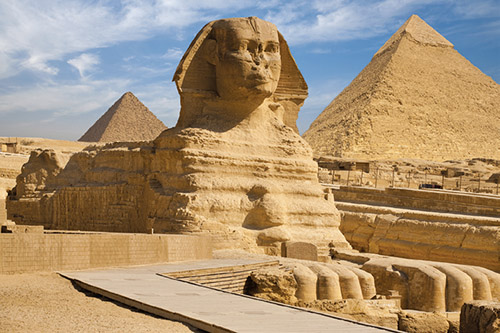

Did you ever wonder which words in Tanach are not Hebrew but are Egyptian? Others have been wondering as well! In 1953, the classic article on this topic was published by Thomas Lambdin in the Journal of the American Oriental Society. Lambdin was a professor of Semitic languages at Harvard for many years. (His “Introduction to Biblical Hebrew” is used as a textbook at YU.)
Of course, identifying Egyptian loanwords in Tanach is not an exact science. We must distinguish between: 1) words that are definitely or almost certainly of Egyptian origin, 2) words that have a significant possibility of being of Egyptian origin, and 3) words for which an Egyptian origin has been suggested but the suggestion is very unlikely. For the most part, Lambdin’s article avoids words in the third category.
I am going to present to you the words that Lambdin included. Usually, the suggested original Egyptian word does not completely match the Hebrew word. But scholars are capable of making educated guesses about which discrepancies are to be expected, and which discrepancies indicate that the supposed word-borrowing should be rejected altogether.
Egyptian is not a Semitic language, unlike Hebrew, Aramaic, Akkadian, Arabic and several others.
In alphabetical order, here are the words that Lambdin included in his article:
Evyon: “poor, needy, wretched.” That this word is of Egyptian origin is a big surprise to me. I had always thought that it came from the Hebrew root A-B-H, which means “to want.”
Avnet: girdle or sash. Lambdin writes that it is “possibly” connected to Egyptian “bnd.”
Avrech: This word appears only at Gen. 41:43. Lambdin comments that the possible Egyptian origin of this word has led to an immense number of suggestions, almost all of which are baseless. But he does allow for the possibility that the word is Egyptian. The suggestion that he takes most seriously is that it means “attention.”
Ach: This word appears only two times, at Jer. 36:22-23. It is a type of ancient fireplace.
Achu: grass or reed (as food for cattle).
Achlamah: This word only appears at Ex. 28:19 and 39:12. In Egyptian, it is the name of a precious stone. The suggested Egyptian origin is based on the assumption that the Egyptian “N” can sometimes be equated with Hebrew “L.” (See also “Leshem” below.)
Etun: This word appears only at Prov. 7:16. It means “red linen.”
Iy: island. We all know this word from Gen. 10:5 and Esther 10:1. It appears many other times in Tanach.
Eifah: measure.
Bahat: This word appears only at Esther 1:6 (floors made of bahat and shesh). Lambdin first suggests an Egyptian origin for this word, a type of stone, but then raises a difficulty with the suggestion.
Butz: linen. We all know this word from its appearance twice in the book of Esther. It appears six other times in Tanach. Lambdin discusses this word at length. He believes that an Egyptian origin is possible but very questionable.
Bochan (“even bochan”): This word appears at Is. 28:16. The meaning in Egyptian is a particular type of stone, perhaps close to granite. (If the word had a Hebrew/Semitic origin, the word would have an unusual meaning: “stone of testing” or “well-tested stone.”)
Bachan: This word appears at Is. 32:14 and 23:13. Based on the Egyptian, the meaning is “castle or fortress.”
Gome: reeds. We all know this word from Ex. 2:3. But it also appears twice in Isaiah and once in Job.
Hovnim: ebony. This word only appears at Ez. 27:15.
Hin: a liquid measure.
Zeret: a unit of measure. Based on the Egyptian, it seems to be related to “hand” or “handful.”
Chanichav: We all know this word from Gen. 14:14. Avraham took these type of men with him when he went to rescue Lot. Based on Egyptian, the meaning seems to be “armed” men. (If the word would be Hebrew/Semitic, the meaning would be something like “trainees,” from chet-nun-caf.)
Chartumim: This word is found in Genesis, Exodus and Daniel. It is always in the plural. Lambdin views it as very likely that this word is of Egyptian origin, but he still cannot prove it. (The Egyptian words that have been suggested are not sufficiently close to the Hebrew.)
Chotam: seal, signet ring. We all know the Hebrew verb chet-tav-mem, which means “to seal.” But since the noun chotam is Egyptian, this means that the Hebrew verb derived from the noun. (Typically in Hebrew, the verb precedes the noun; the noun is formed by taking the three-letter root of the verb and adding a mem or a tav as the initial letter.)
Taba’at: signet ring, seal. The Egyptian word is something like “gbt,” but Lambdin believes that this is a sufficient match. I had always thought that taba’at came from the Hebrew/Semitic tav-bet-ayin, which meant “press down.”
Tene: basket. This word only appears in Deuteronomy (four times).
Ye’or: Originally, this was the word for “the Nile.” Later, the meaning became “a river.”
Ketem: valuable type of gold. Lambdin believes that the word is foreign to both Hebrew and Egyptian and originally came from Sumerian.
Leshem: a type of precious stone. It is mentioned only at Ex. 28:19 and 39:12. It derives from the Egyptian N-Sh-M.
Marach: “to anoint a wound.” It is found at Is. 38:21.
Nofek and Puk: Each appear a few times. The meaning is “turquoise” or “malachite stone.”
Neter: This word appears two times: at Prov. 25:20 and Jer. 2:22. The meaning is “natron,” which is a natural soda consisting essentially of sodium carbonate and sodium bicarbonate.
Suf: fresh-water reed, seaweed.
Pach: Sometimes this word means a trap used to trap chickens. Other times it is a thin sheet of metal. Both of these are of Egyptian origin.
Tzi: ship. This word appears only three times in Tanach.
Kof: ape, monkey. This word only appears two times in Tanach (in the plural).
Kalachat: pot, kettle. This word only appears two times in Tanach. The Egyptian original is K-R-Ch-T.
Keset: an ink vessel. This word appears only three times, all in Ezekiel Chapter 9.
Shushan: a type of flower. (I had always thought the word was Hebrew/Semitic and originated as a “flower with six petals.”)
Shitah (almost always in the plural, Shitim): acacia.
Sechiyot: ships. This word only appears at Is. 2:16. Those assuming it was Hebrew thought it came from the root sin, caf, he, which meant “look.” The meaning might be “objects to be looked at” or “images.” But at Is. 2:16, it is parallel to oniot=ships. Thus, the Egyptian etymology fits much better!
Shasah: to plunder. We should all know this root from Lecha Dodi: ve-hayu le-meshisah shosayich—“they who spoil thee shall become spoil.” The original Egyptian term is “shasu,” which means nomads or marauders.
Sha’atnez: Lambdin suggests an Egyptian origin for this difficult word, related to an Egyptian word that means “weave.” But he admits that his suggestion is conjectural.
Shayish: white marble. Shayish appears at 1 Chr. 29:2. The same word in a different form, shesh, appears twice in Est. 1:6 and once in Shir HaShirim. The Egyptian word meant “alabaster.”
Shesh: fine linen. This word appears many times in Tanach.
Tachra: This word appears at Ex. 28:32 and 39:23. It is a type of garment. Lambdin mentions a scholar who suggested an Egyptian origin but he doubts that the suggestion is correct.
Did any of you notice that I left out one significant word? Yes, I left out Paroh. This word is certainly Egyptian and originally meant “great house.”
So now, if anyone ever asks you how many Egyptian loanwords there are in the Tanach, you know that there are not just a handful. But neither are there 100. As Lambdin realizes, some of the suggestions he included are probably not correct. On the other hand, for the most part, he did not include words that had an Egyptian origin suggestion that he viewed as very unlikely. But some of these unlikely suggestions may be correct. So the actual number of Egyptian loanwords in Tanach is probably around 40.
By Mitchell First
Mitchell First is a personal injury attorney and Jewish history scholar. He can be reached at MFirstAtty@aol.com. He was once able to (barely) read ancient Persian cuneiform. He admits he knows nothing about ancient Egyptian.
For more articles by Mitchell First, and information on his books, please visit his website at rootsandrituals.org.











